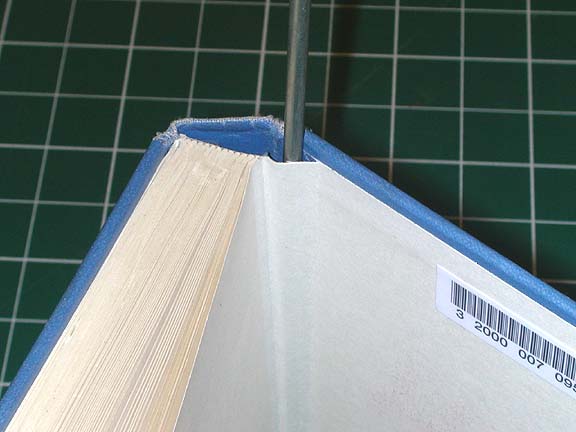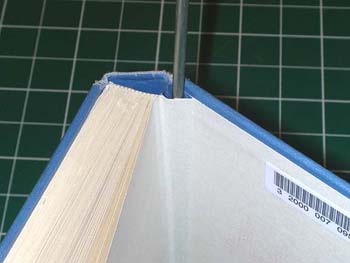Indiana University Libraries Book Repair Manual
Hinge Tightening
Treatment Criteria:
- super-to-board(s) attachment is loose, but the super is not damaged
- boards of the case are in decent useable condition
- spine of the case may or may not be damaged

Tools Needed: |
|
Materials Needed: |
 | The illustration shows a typical example. The super-to-boards attachment is loose on one or both sides, but the super is in no way damaged, and the super-to-text block attachment is fine. For the purpose of illustration, the example shown has one side of the case's spine damaged, allowing the cover material of the spine to be flapped back. This affords a good view of the loose hinge. The red arrows show the points of the case's spine that would be joined, were the cover material intact. |
 |
For further illustration, here's the same image, but in drawing form. This book will also need a spine repair, but the hinge needs to be tightened first. By doing the hinge tightening before the spine repair, the repair will amount to a simple matter of applying adhesive to the exposed inner surface of the board and placing the book in a standing press. The blue cross-hatched area indicates where the adhesive is to be applied.
|
 |
This extreme example serves well for the purpose of illustration. As you can see, the separation of the super and the paste-downs from the boards extends well beyond the full width of the super. At this point, the entire book is being held together by paper, namely the paste-downs.
|
 | This illustration shows the procedure for tightening the hinges of a book which has the cover material of the case's spine intact. This repair employs the use of a metal rod about the diameter of a knitting needle (in fact, a knitting needle works fine). The rod/needle is covered with adhesive and placed down into the loose hinge. Usually, giving it a spin helps administer the adhesive. When this is done, the book is placed in a finishing press for about a day. |